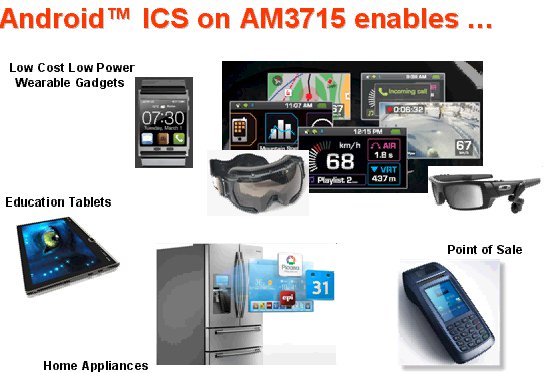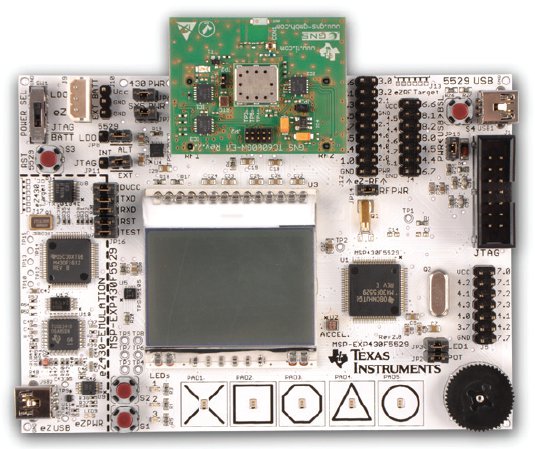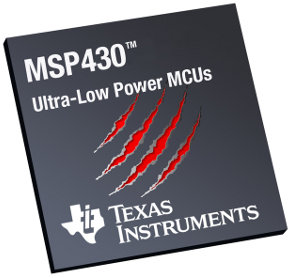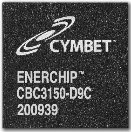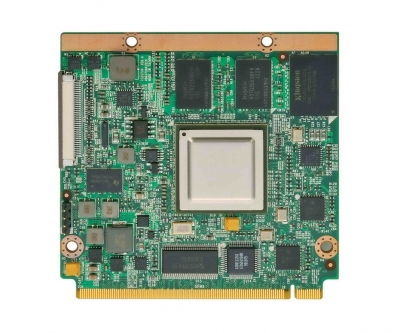After collaborating with arowboat, android-porting and Linaro communities, Texas Instruments has released Android 4.0.3 development kits for Sitara microprocessors which support Beagleboard-XM (Sitara DM3730) and Beaglebone (Sitara AM335x) low cost development boards, as well as other Sitara-based evaluation modules and development boards. Android 4.0.3 Devkit for Beaglebone If you have a Beaglebone (and an LCD or DVI-D cape), you can use TI Android ICS 4.0.3 DevKit v3.0.1, a release providing an Android ICS 4.0.3 distribution for TI’s Sitara AM335x ARM Cortex A8 Processors. This DevKit provides Android sources with pre-integrated SGX (3D graphics accelerator) drivers, TI hardware abstraction for Audio, WLAN & Bluetooth for TI WL1271 chipset, USB mass storage, etc, as well as development and debugging tools such as a toolchain, TI CCSv5, ADT plugins and more, which are provided to build custom Android solutions for the embedded market more easily. The pre-built images includes Android default apps, multimedia […]
TI SimpleLink GPS CC4000 Enables GPS For MCUs
Yesterday, Texas Instruments unveiled the SimpleLink GPS CC4000, a GPS self-contained module that can be interfaced with any MCU or MPU having a UART interface. Due to limited resources of microcontrollers, several GPS features have been implemented in hardware such as the push-to-fix function which can simply be controlled by the MCU via a GPIO to receive National Marena Electronics Association (NMEA) strings containing location, time and velocity information. TI Simplelink GPS CC4000 enables GPS-based applications such as asset tracking, industrial M2M, sports and fitness, and precision timing. It can deliver better than 2.5 meter accuracy and provides pulse-per-second output functions to provide precise location and timing data. It can also automatically reuse previously decoded satellite information thanks to its “watchful-eye” feature in order to deliver fast time to first fix (TTFF) and optimize power consumption. Here are SimpleLink GPS CC4000 key features: Driverless, fully integrated GPS solution which requires […]
Using Android Outside the Mobile Phone Space – Android Builder Summit 2012
Jason Kridner, chief software architect for the Sitara ARM microprocessor business at Texas Instruments (TI) and the community development manager, explains why and how to use Android in diverse embedded systems (and not only smartphones and tablets) at the Android Builder Summit in February 2012. Abstract: A few years back all embedded devices were designed like PCs. For example, users understood the use of a mouse and keyboard and could minimize and maximize a window using mouse clicks and launch new applications from Start. The increasing demand and usage of smartphones globally has not just changed the definition of user experience for embedded equipments but has made emerging technologies like touch and display panels, connectivity solutions and infrastructure, affordable to non- phone products segments. The embedded equipment designers and users have grown accustomed in no time to the smartphone features and technologies like multi-touch, high-resolution display panels, connectivity over 3G […]
Texas Instruments Announces Ultra-Low Power MSP430 “Wolverine” MCU Series
Texas Instruments announced a new series of its MSP430 MCUs codenamed “Wolverine” for its aggressive power-saving technology. The company claims this ultra-low-power MSP430 microcontroller platform offers at least 50 percent less power consumption than any other micro-controller in the industry with 360 nA RTC mode and less than 100 µA/MHz active power consumption. Since typical battery powered applications spend as much as 99.9 percent of their time in standby mode, Wolverine MCUs power consumption of 360 nA in standby mode would more than double the battery life. Here are the key power savings techniques and technology using the the Wolverine MCU (MSP430FR58xx): Ultra low leakage (ULL) process technology. TI developed ULL technology that offers a 10x improvement in leakage and optimized mixed signal capabilities. Power reduction are also achieved thanks to an improved 130 nm process technology and more than 30 power-optimized analog and digital components. Unified FRAM (Ferroelectric Random […]
Texas Instruments OMAP5 Demo at MWC 2012
Charbax of armdevices.net has uploaded a very interesting video with an OMAP5430 demo and an interview at Texas Instruments booth at MWC 2012. Using the OMAP5 development kit, they demo several 3D applications, the web browser and the picture gallery and it looks extremely smooth. They discussed about the OMAP5 vs Tegra 3 benchmark, and it appears mobile web browsers are not yet optimized for more than 2 cores which could explain the performance difference somewhat. The OMAP5 currently runs at 800 MHz, but there will eventually be 2 versions: 1.7 and 2.0 GHz when the OMAP 5 AP is released. This should show a performance improvement of over 4x against the Tegra 3, although I’m sure in the meantime, Nvidia will have announced the Tegra 4 (Wayne). The OMAP 5 also offers impressive improvement in power consumption, as the SGX544 GPU cores are augmented by a dedicated 2D hardware-accelerated […]
TI Dual Core OMAP 5 Cortex A15 (800 Mhz) Twice as Fast as Nvidia Tegra 3 Quad Core Cortex A9 (1.3 Ghz)
Texas Instruments released a video showing the Web page loading time between TI OMAP 5 featuring two ARM Cortex-A15 cores at 800MHz (as well as specialized cores and accelerators), compared to a commercial device powered by a quad-core ARM Cortex-A9 processor at 1.3 GHz. They did not say it, but it’s got to be the Nvidia Tegra 3 since this is the only ARM Cortex A9 Quad-core processor with products available on the market today. In this benchmark, the devices handle 3 tasks simultaneously: Rendering 20 web pages Downloading videos Play a MP3 file The result is quite amazing, even hard to believe, with the OMAP 5 rendering the 20 pages in 95 seconds whereas it took the NVidia Tegra 3 over 200 seconds. I’m sure we’ll get an explanation of this performance difference at MWC 2012. Jean-Luc Aufranc (CNXSoft)Jean-Luc started CNX Software in 2010 as a part-time endeavor, before […]
Cymbet EnerChip Solid State Batteries and Energy Harvesting Evaluation Kits
Cymbet has developed rechargeable solid state batteries called EnerChip for Embedded Energy, Power Backup and Energy Harvesting. Applications include backing up Real Time Clocks (RTC), Micro-controllers (MCU) and SRAM devices. The company says “EnerChips are ideal for energy harvesting powered devices such as wireless sensors, medical devices, data loggers and remote location tracking equipment.” Those chipsets aim at replacing batteries such as CR2032 batteries that you can find in watches, calculators and other low power devices. The company emphasized three key benefits of such “batteries”: EnerChips are more than 10x smaller than non-rechargeable coin cell batteries EnerChips last 3x longer than conventional coin cell batteries EnerChips are less expensive to use than conventional coin cell batteries or super caps. The price starts at 20 US cents in volume quantities. You can watch the promotion video below for an overview of those chips. Cymbet shows a lot of mobile phones in their video, […]
GreenBase GQ-3874 and CG-8148 TI ARM Cortex A8 QSeven Modules
GreenBase Technology has unveiled the GQ-3874 and GQ-8148 Qseven modules based on Texas Instruments Cortex A8 processors. The GQ-3874/8148 features a PCI-e slot, SATA, four USB, four UART, dual CAN bus, ARM Cortex A8 1GHz processor, and SGX530 3D graphics engine. The GQ-3874 – Qseven Module uses the following CPU and GPU: CPU – Texas Instruments Sitara AM3874 1GHz ARM Cortex-A8 MPU GPU – SGX530 3D Graphics Engine and the GQ-8148 – Qseven Module uses the following CPU, GPU, DSP and Video hardware accelerator: CPU – Texas Instruments DaVinci DM8148 1GHz ARM Cortex-A8 MPU GPU – SGX530 3D Graphics Engine DSP – Integra C674 750MHz DSP HDVICP2 Video Encoder/Decoder hardware accelerator Both boards share the following specifications: Memory & Storage Onboard DDR3 Memory 512MB/1GB Onboard eMMC Flash 4GB/8GB Qseven 230 pin Edge Connector with: 2 x GbE 1 x PCIe 1 x SATA 1 x HDMI 4 x USB 2.0 […]


